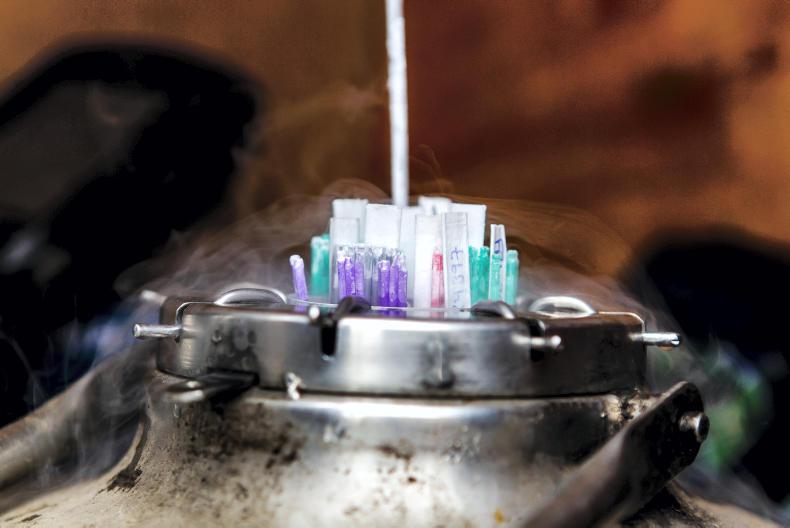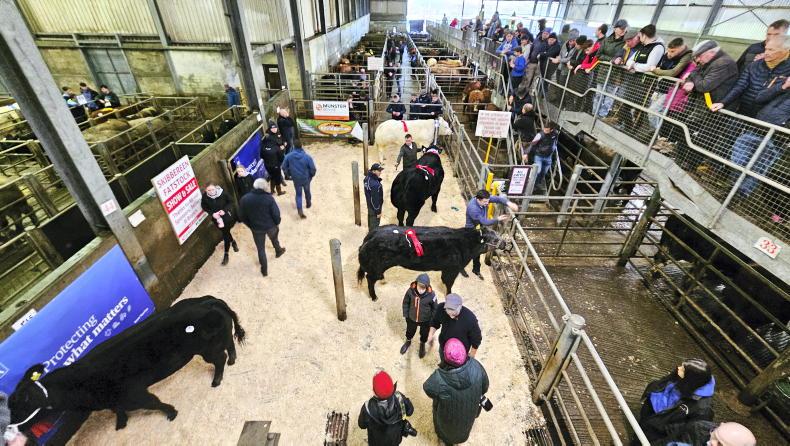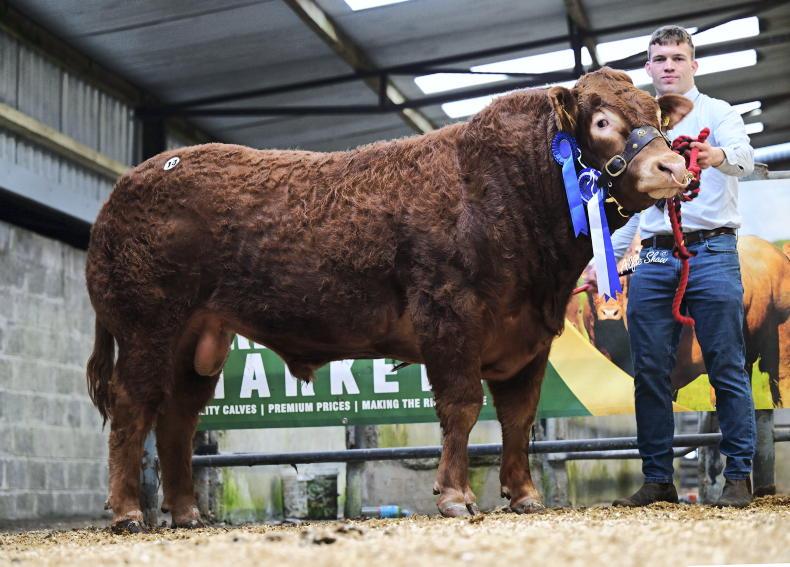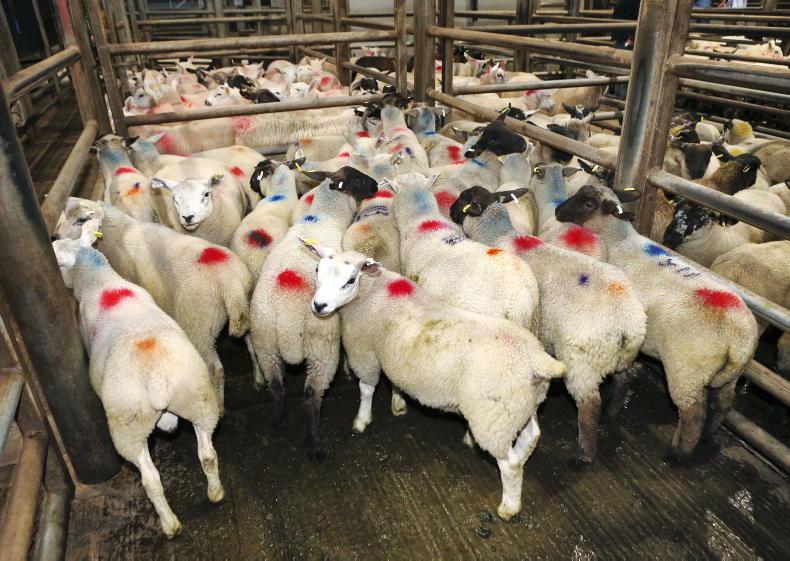Last week’s Irish Farmers Journal carried a report published by the ICBF on the performance of different breeds in the Irish dairy herd. The ICBF concluded farmers should ignore breed and pick bulls based on EBI. The methodology used to come to this conclusion will be examined later. Over the past week I have been in contact with geneticists from around the world, asking them about breeding in their countries. The purpose of this is to get an international perspective of breeding programmes and to help inform the debate in Ireland.
Julie Clasen, geneticist at Swedish University of Agricultural Science.
Sweden is a part of the Nordic Cattle Breeding Evaluation (NAV), which covers breeding programmes for Holstein, Red Dairy Cattle and Jersey in Denmark, Sweden and Finland. In Sweden, the major breeds are Holstein (56%) and Swedish Red (35%), and 8% are a crossbred of the two main breeds. Only 1% of cows in Sweden are Jersey. In terms of bull selection, Holstein dominates, with 56% of inseminations. Swedish Red is at 30% and the rest is beef semen.
Holstein and Swedish Red are economically equal in Sweden – or at least they were when last compared in 2014
Julie says more than 80% of the herds are mixed breed herds, meaning they keep both breeds (without crossbreeding them). Swedish Red used to be the major breed up to 20 years ago, which might explain why many farms still have both breeds. I asked Julie if there was a difference in the economic breeding value between the breeds;
“Holstein and Swedish Red are economically equal in Sweden – or at least they were when last compared in 2014. Last year the Danish Holstein and Danish Red were proved economically equal. The breeds are somewhat similar between the two countries, so it is likely the same for the Swedish animals. They complement each other well in crossbreeding: Holstein adding great milk yield and udder conformation while Swedish Red has superior fertility, health traits and body condition,” Julie says.
The less young stock needed for replacements, the better the environmental efficiency
At least 95% of all inseminations in Sweden are to genomically selected bulls, with the remaining 5% to daughter-proven bulls. Genomics has been available for all breeds in the Nordic countries since 2010. A paper by Julie was published last year, showing that crossbreeding has the potential to increase annual profit by €39/cow in conventional dairy herds in Sweden.
When asked what traits farmers should select to improve environmental efficiency, Julie says fertility and longevity are key: “The less young stock needed for replacements, the better the environmental efficiency. Now, if the average age of the cows in the herd increases it will also increase the generation interval and thus reduce the genetic progress in the herd.
“But this can be counteracted if sexed semen is used on the youngest females to produce the future replacement animals and beef semen is used on the remaining animals. Using beef semen in dairy will also increase environmental efficiency, as the beef output from dairy herd will increase.
Belgian Blue is forbidden to use in Sweden
“The use of sexed semen is about 10-15% in Sweden, but expected to increase. The proportion of beef semen is about the same as sexed semen, but is larger in Swedish Red than Holstein, because the Swedish Red breed has better fertility and beef semen is used to reduce the number of surplus replacement heifers. Breeds used for beef AI are mainly Charolais, Simmental and Limousin, but Swedish farmers don’t mind breeding Angus or Hereford to heifers. Belgian Blue is forbidden to use in Sweden.”
Jennie Pryce, principal research scientist, Agriculture Research Victoria.
The dominant breeds in Australia are Holstein Friesian and Jersey. The exact proportion of each is difficult to tell but based on a number of datasets about 70% of cows are Holstein Friesian, 20% are Jersey and 4% are Holstein/Jersey crossbred.
You benefit from heterosis in crossing breeds
Because genetic evaluations in Australia are conducted within as opposed to across breeds, Jennie says it’s not possible to draw direct comparisons between the different breeds in terms of economic breeding values.
I asked Jennie for her views on crossbreeding: “You benefit from heterosis in crossing breeds and that has a particularly favourable effect on fitness traits, such as longevity, calf survival and fertility.
“For the first-cross, typical estimates of 10% greater performance than parent average are common.
“One of the issues of within breed selection is the rate of inbreeding and there is now growing evidence from around the world that increased rates of genetic gain have been associated with increased rates of inbreeding.
We still obviously need purebred populations for good within-breed selection decisions so that we can continue with crossbreeding programmes
“For numerically smaller breeds, such as Jerseys, it is becoming very difficult to identify outcross animals for breeding programmes. I think this will lead to greater crossbreeding as a way to remain profitable.
“However, we still obviously need purebred populations for good within-breed selection decisions so that we can continue with crossbreeding programmes. The smartest crossbreeding programmes identify the best breeds for a production system and the best animals within those breeds. Crossbreeding should never be seen as a replacement for within-breed selection.”
Paul Vanraden, geneticist, USDA, Maryland.
Based on Dairy Herd Improvement data (44% of all US cows have a genetic evaluation), there has been substantial change in the make-up of the US dairy herd since 1990. The percentage of cows with Holstein Friesian as their breed code declined from 90.6% in 1990 to 81.4% in 2018. Over this period, Jersey cows increased from 5.7% to 12.2% and crossbreds increased from 0.1% to 5.3%.
Holstein remains the dominant breed on US dairy farms, with over 70% of farms having at least 90% Holstein cows in their herd. However, 25% of herds now have some Jersey cows (up from 10% in 1990) and 35% of herds now have some crossbred cows (up from 3% in 1990).
In terms of on-farm performance, Jersey cows in the US have lower milk volume but higher milk constituents and better fertility performance than Holstein cows
The Net Merit Index is used to rank bulls in terms of their economic value in the US. As per the April 2020 evaluation, the top available Holstein bulls have a higher Net Merit Index compared to the top available Jersey bulls.
In terms of on-farm performance, Jersey cows in the US have lower milk volume but higher milk constituents and better fertility performance than Holstein cows. Production and fertility data is not available for crossbred cows but culling data is. More crossbred cows (72.9%) stay in the herd or are sold for dairy compared to Jersey (72.7%) or Holstein (67.6%) cows. To put this another way, 27% of crossbred cows were sold for slaughter or died, compared to 32% for Holstein cows.
Brian Wickham, manager, NZ Animal Evaluation Limited.
Breed data shows that 49% of all cows in New Zealand are Holstein Friesian/Jersey crossbred, 33% are Holstein Friesian while 9% are Jersey. New Zealand’s breeding programme is centred on Breeding Worth (BW), an economic multi-trait index for cows and bulls.
BW is highest in Jersey cows followed by crossbred and then Holstein Friesian cows while the rate of gain in cow BW is similar for all three breeds.
As of the April 2020 Ranking of Active Sires evaluation run (equivalent of ICBF Active Bull List) 27 of the top 30 bulls are Jersey with the other three bulls being crossbred.
Do we have the resources for two breeding programmes?
A new paper has just been published in the Journal of Dairy Science on the rate of inbreeding in the North American Holstein and Jersey cow population. The study examined the rate of inbreeding between 1990 and 2018 and found that genomic selection has accelerated the rate of inbreeding.
This is due to what they call reduced generational interval. So because sires are now younger, they are more closely related to the cows they are being used on.
There is a need to implement measures and means for controlling the rate of inbreeding per year
In the paper, Bayode O Makanjuola concludes that given the increased rate of inbreeding after genomic selection and the deleterious effect that can have on animal performance in both the Holstein and Jersey breeds, there is a need to implement measures and means for controlling the rate of inbreeding per year, which will help to manage and maintain farm animal genetic resources.
One of the ways to achieve this is to maintain a pure population of two or more breeds and then use crossbreeding to increase genetic diversity.
In Ireland, genomic selection for the Jersey breed was introduced in 2020, 11 years later than Holstein Friesian, seven years later than beef breeds and 10 years after it was introduced in the Nordic countries.
There will always be a benefit of having multiple breeds in a breeding programme
According to Teagasc’s Donagh Berry, Irish farmers have to decide if they want a multiple breeding programme or not. He predicts that by 2035 the gain from crossbreeding (hybrid vigour) will have been eroded by continual increases in the genetic merit of the Holstein Friesian breed, unless something changes.
“There will always be a benefit of having multiple breeds in a breeding programme but only if they are (close to) equal genetic merit and you exploit crossbreeding, which is just the opposite of inbreeding. But the question is do we have the resources for two breeding programmes?
“Do we have the interest in it and are we willing to use enough young Jersey bulls so it competes with the Holstein breeding programme. For crossbreeding to work we need breeds of high genetic merit. If you’re just looking for hybrid vigour then the best thing to do is to breed your cows to a Charolais bull.
“You’ll have loads of hybrid vigour, but not a very profitable cow. Therefore, as the difference in EBI between breeds grows, the benefit of crossbreeding erodes,” Donagh says.
Read more
Genetic gain: is crossbreeding redundant?
April milk price cut as market prices improve
Last week’s Irish Farmers Journal carried a report published by the ICBF on the performance of different breeds in the Irish dairy herd. The ICBF concluded farmers should ignore breed and pick bulls based on EBI. The methodology used to come to this conclusion will be examined later. Over the past week I have been in contact with geneticists from around the world, asking them about breeding in their countries. The purpose of this is to get an international perspective of breeding programmes and to help inform the debate in Ireland.
Julie Clasen, geneticist at Swedish University of Agricultural Science.
Sweden is a part of the Nordic Cattle Breeding Evaluation (NAV), which covers breeding programmes for Holstein, Red Dairy Cattle and Jersey in Denmark, Sweden and Finland. In Sweden, the major breeds are Holstein (56%) and Swedish Red (35%), and 8% are a crossbred of the two main breeds. Only 1% of cows in Sweden are Jersey. In terms of bull selection, Holstein dominates, with 56% of inseminations. Swedish Red is at 30% and the rest is beef semen.
Holstein and Swedish Red are economically equal in Sweden – or at least they were when last compared in 2014
Julie says more than 80% of the herds are mixed breed herds, meaning they keep both breeds (without crossbreeding them). Swedish Red used to be the major breed up to 20 years ago, which might explain why many farms still have both breeds. I asked Julie if there was a difference in the economic breeding value between the breeds;
“Holstein and Swedish Red are economically equal in Sweden – or at least they were when last compared in 2014. Last year the Danish Holstein and Danish Red were proved economically equal. The breeds are somewhat similar between the two countries, so it is likely the same for the Swedish animals. They complement each other well in crossbreeding: Holstein adding great milk yield and udder conformation while Swedish Red has superior fertility, health traits and body condition,” Julie says.
The less young stock needed for replacements, the better the environmental efficiency
At least 95% of all inseminations in Sweden are to genomically selected bulls, with the remaining 5% to daughter-proven bulls. Genomics has been available for all breeds in the Nordic countries since 2010. A paper by Julie was published last year, showing that crossbreeding has the potential to increase annual profit by €39/cow in conventional dairy herds in Sweden.
When asked what traits farmers should select to improve environmental efficiency, Julie says fertility and longevity are key: “The less young stock needed for replacements, the better the environmental efficiency. Now, if the average age of the cows in the herd increases it will also increase the generation interval and thus reduce the genetic progress in the herd.
“But this can be counteracted if sexed semen is used on the youngest females to produce the future replacement animals and beef semen is used on the remaining animals. Using beef semen in dairy will also increase environmental efficiency, as the beef output from dairy herd will increase.
Belgian Blue is forbidden to use in Sweden
“The use of sexed semen is about 10-15% in Sweden, but expected to increase. The proportion of beef semen is about the same as sexed semen, but is larger in Swedish Red than Holstein, because the Swedish Red breed has better fertility and beef semen is used to reduce the number of surplus replacement heifers. Breeds used for beef AI are mainly Charolais, Simmental and Limousin, but Swedish farmers don’t mind breeding Angus or Hereford to heifers. Belgian Blue is forbidden to use in Sweden.”
Jennie Pryce, principal research scientist, Agriculture Research Victoria.
The dominant breeds in Australia are Holstein Friesian and Jersey. The exact proportion of each is difficult to tell but based on a number of datasets about 70% of cows are Holstein Friesian, 20% are Jersey and 4% are Holstein/Jersey crossbred.
You benefit from heterosis in crossing breeds
Because genetic evaluations in Australia are conducted within as opposed to across breeds, Jennie says it’s not possible to draw direct comparisons between the different breeds in terms of economic breeding values.
I asked Jennie for her views on crossbreeding: “You benefit from heterosis in crossing breeds and that has a particularly favourable effect on fitness traits, such as longevity, calf survival and fertility.
“For the first-cross, typical estimates of 10% greater performance than parent average are common.
“One of the issues of within breed selection is the rate of inbreeding and there is now growing evidence from around the world that increased rates of genetic gain have been associated with increased rates of inbreeding.
We still obviously need purebred populations for good within-breed selection decisions so that we can continue with crossbreeding programmes
“For numerically smaller breeds, such as Jerseys, it is becoming very difficult to identify outcross animals for breeding programmes. I think this will lead to greater crossbreeding as a way to remain profitable.
“However, we still obviously need purebred populations for good within-breed selection decisions so that we can continue with crossbreeding programmes. The smartest crossbreeding programmes identify the best breeds for a production system and the best animals within those breeds. Crossbreeding should never be seen as a replacement for within-breed selection.”
Paul Vanraden, geneticist, USDA, Maryland.
Based on Dairy Herd Improvement data (44% of all US cows have a genetic evaluation), there has been substantial change in the make-up of the US dairy herd since 1990. The percentage of cows with Holstein Friesian as their breed code declined from 90.6% in 1990 to 81.4% in 2018. Over this period, Jersey cows increased from 5.7% to 12.2% and crossbreds increased from 0.1% to 5.3%.
Holstein remains the dominant breed on US dairy farms, with over 70% of farms having at least 90% Holstein cows in their herd. However, 25% of herds now have some Jersey cows (up from 10% in 1990) and 35% of herds now have some crossbred cows (up from 3% in 1990).
In terms of on-farm performance, Jersey cows in the US have lower milk volume but higher milk constituents and better fertility performance than Holstein cows
The Net Merit Index is used to rank bulls in terms of their economic value in the US. As per the April 2020 evaluation, the top available Holstein bulls have a higher Net Merit Index compared to the top available Jersey bulls.
In terms of on-farm performance, Jersey cows in the US have lower milk volume but higher milk constituents and better fertility performance than Holstein cows. Production and fertility data is not available for crossbred cows but culling data is. More crossbred cows (72.9%) stay in the herd or are sold for dairy compared to Jersey (72.7%) or Holstein (67.6%) cows. To put this another way, 27% of crossbred cows were sold for slaughter or died, compared to 32% for Holstein cows.
Brian Wickham, manager, NZ Animal Evaluation Limited.
Breed data shows that 49% of all cows in New Zealand are Holstein Friesian/Jersey crossbred, 33% are Holstein Friesian while 9% are Jersey. New Zealand’s breeding programme is centred on Breeding Worth (BW), an economic multi-trait index for cows and bulls.
BW is highest in Jersey cows followed by crossbred and then Holstein Friesian cows while the rate of gain in cow BW is similar for all three breeds.
As of the April 2020 Ranking of Active Sires evaluation run (equivalent of ICBF Active Bull List) 27 of the top 30 bulls are Jersey with the other three bulls being crossbred.
Do we have the resources for two breeding programmes?
A new paper has just been published in the Journal of Dairy Science on the rate of inbreeding in the North American Holstein and Jersey cow population. The study examined the rate of inbreeding between 1990 and 2018 and found that genomic selection has accelerated the rate of inbreeding.
This is due to what they call reduced generational interval. So because sires are now younger, they are more closely related to the cows they are being used on.
There is a need to implement measures and means for controlling the rate of inbreeding per year
In the paper, Bayode O Makanjuola concludes that given the increased rate of inbreeding after genomic selection and the deleterious effect that can have on animal performance in both the Holstein and Jersey breeds, there is a need to implement measures and means for controlling the rate of inbreeding per year, which will help to manage and maintain farm animal genetic resources.
One of the ways to achieve this is to maintain a pure population of two or more breeds and then use crossbreeding to increase genetic diversity.
In Ireland, genomic selection for the Jersey breed was introduced in 2020, 11 years later than Holstein Friesian, seven years later than beef breeds and 10 years after it was introduced in the Nordic countries.
There will always be a benefit of having multiple breeds in a breeding programme
According to Teagasc’s Donagh Berry, Irish farmers have to decide if they want a multiple breeding programme or not. He predicts that by 2035 the gain from crossbreeding (hybrid vigour) will have been eroded by continual increases in the genetic merit of the Holstein Friesian breed, unless something changes.
“There will always be a benefit of having multiple breeds in a breeding programme but only if they are (close to) equal genetic merit and you exploit crossbreeding, which is just the opposite of inbreeding. But the question is do we have the resources for two breeding programmes?
“Do we have the interest in it and are we willing to use enough young Jersey bulls so it competes with the Holstein breeding programme. For crossbreeding to work we need breeds of high genetic merit. If you’re just looking for hybrid vigour then the best thing to do is to breed your cows to a Charolais bull.
“You’ll have loads of hybrid vigour, but not a very profitable cow. Therefore, as the difference in EBI between breeds grows, the benefit of crossbreeding erodes,” Donagh says.
Read more
Genetic gain: is crossbreeding redundant?
April milk price cut as market prices improve










SHARING OPTIONS